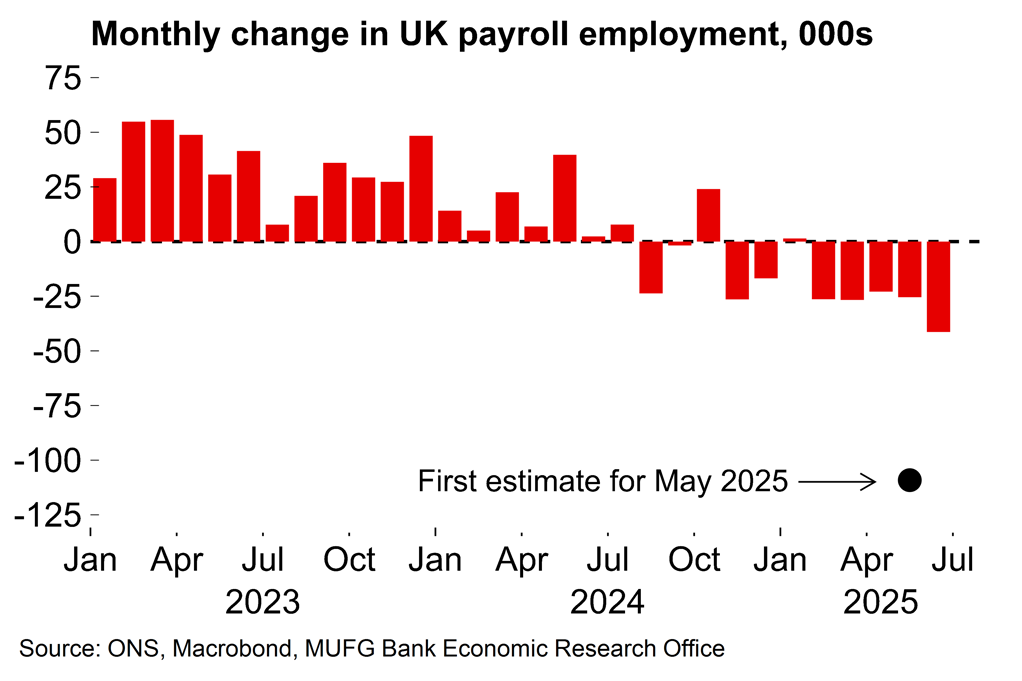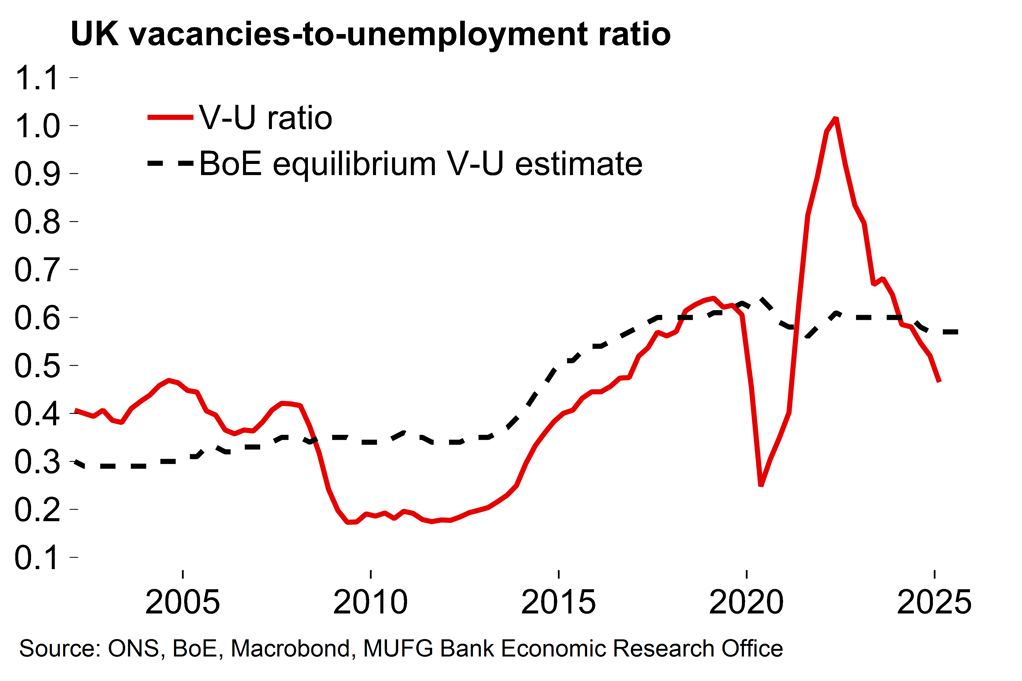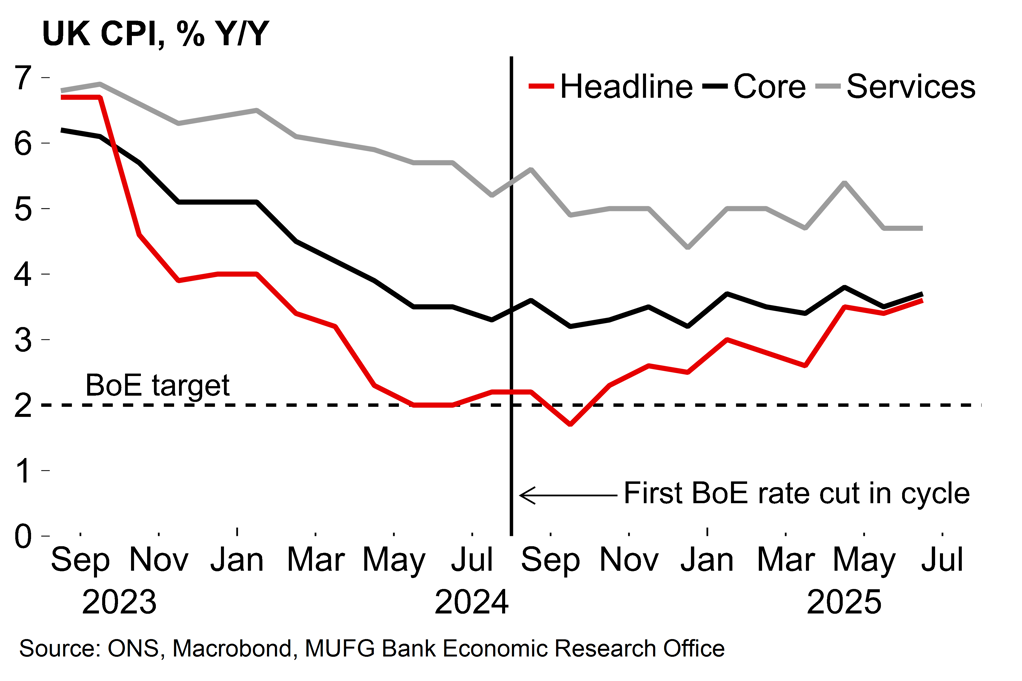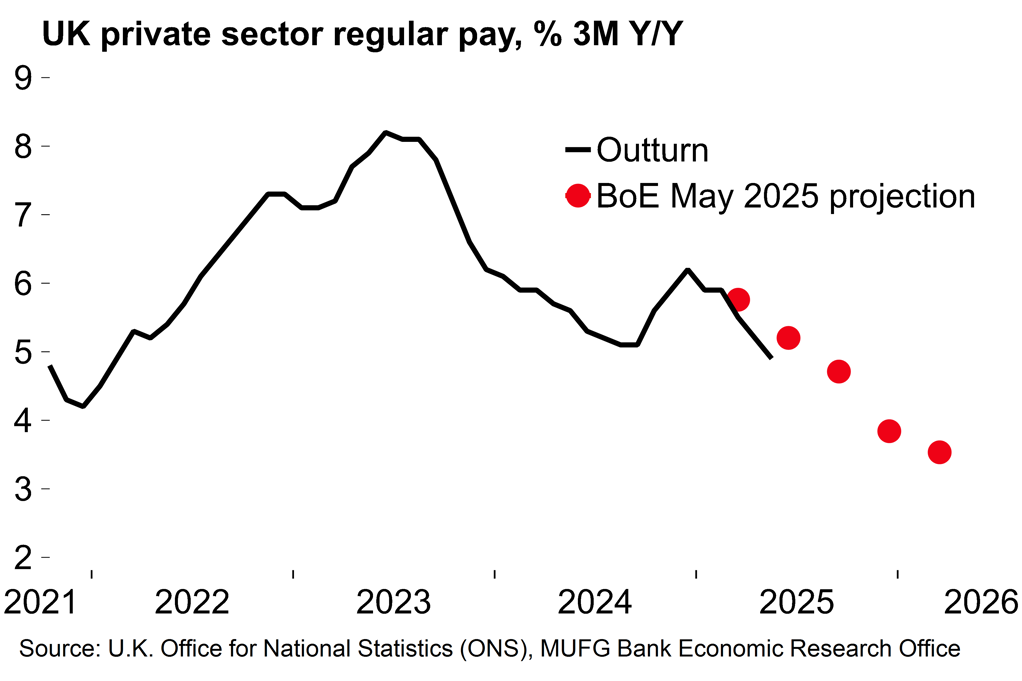- The BoE is set to extend its well-established quarterly easing cycle with another 25bp cut next week, taking rates to 4.0%.
- UK data has been mixed since the last meeting. Inflation surprised to the upside in June and employment data has been less alarming than initially feared. But labour market slack continues to open up and wage growth is undershooting the BoE’s previous projections. In short, there’s ammunition for both hawks and doves and so a sudden outbreak of unity on the MPC looks unlikely. We have pencilled in another fragmented vote split and see four dissenters (two for a pause and two for a larger cut).
- We expect little change in either the BoE’s core guidance or medium-term projections (although near-term inflation numbers are set to be lifted). The focus will be on the vote split and discussion around it, as well as the framing of other risks e.g. food prices/household inflation expectations and trade diversion/supply chain disruption.
- Looking ahead, the path for interest rates is likely to remain downwards and we see little reason to expect a deviation from the current pace of easing which, we suspect, will remain the path of least resistance in a divided MPC. By the autumn, further signs of labour market slack and sluggish growth (with sentiment possibly weakening around the Budget) will likely help to counter concerns about above-target inflation.
Less alarming employment data and sticky inflation – but labour market slack is still increasing
The Bank of England is set to extend its quarterly easing cycle with another 25bp cut at next week’s meeting, taking rates down to 4.0%. A cut is almost fully priced in by market participants.
Data since the last meeting in June (which was mildly dovish – see our take on that here) has been mixed from a monetary policy perspective. On balance, the case for an ‘extra’ (i.e. back-to-back) cut this year has weakened following an upside inflation surprise and less alarming employment data.
The headline CPI rate increased from 3.4% to 3.6% in June, with the services gauge remaining stuck at 4.7%. Food inflation – which can have a big influence on household inflation expectations – also moved higher, and the latest BRC survey pointed to further upward pressure in July.
The sharp plunge in the first estimate of payrolls employment for May was largely revised away in the next release (from -109k to -26k). Based on the recent trend for revisions we’d assume that the -41k move in June payrolls will also be revised favourably. Looking at other numbers, e.g. redundancy notifications, there is little evidence of an ‘abrupt loosening’ scenario emerging.
But the general picture of increased UK labour market slack remains in place. The single-month unemployment rate rose to 4.7% in April, from 4.4% at the start of the year. The vacancies-to-unemployment ratio is below the BoE's estimate of equilibrium, and continues to decline. Against that backdrop, wage growth momentum is fading – private sector regular pay growth was 3.7% in May on a three-month annualised basis. Forward-looking survey estimates suggest pay pressures could continue to ease.
The alarming first estimate of May employment was largely revised away…

…but UK labour market slack is clearly increasing

Things also look soft on the activity side. There was an unexpected contraction in the monthly GDP figure for May and retail sales data for June was disappointing. The BoE’s latest estimate for Q2 GDP growth (0.25%) now looks optimistic, and business survey data suggests that growth momentum at the start of H2 is limited. The latest consumer confidence figures also indicate that households are wary of painful autumn Budget measures and may try to increase savings over coming months.
Another quarterly cut (and another split vote)
In short, there’s ammunition here for both hawks and doves. That means an extension of the current cut-pause cycle remains the default path, we suspect, but a sudden outbreak of unity on the MPC looks unlikely. For next week’s meeting we have pencilled in a three-way vote split with two dissenters on each side. We see Mann and Pill voting for another pause, while arch-dove Dhingra and Taylor (who we think will continue to make the case for an ‘extra’ cut this year) could vote for a larger 50bp cut. This would replicate the May vote split.
We don’t expect huge shifts in the updated projections. While the BoE is set to revise its near-term expectations for inflation upwards (it had previously estimated headline rates would remain at 3.4% over coming months), we suspect this will be presented as a temporary deviation with the profile remaining broadly similar further ahead. The effect of weaker sterling and higher energy pricing since May is likely to be counterbalanced by a slight hawkish shift in market rate expectations and the undershoot on wage growth. Likewise, near-term GDP numbers look softer, as noted above, but the Q1 figure was revised up (0.6 to 0.7% Q/Q) and so, in levels, things are likely to look fairly similar further ahead in the projection horizon.
Sticky underlying inflation pressures over the last year have bolstered the case for caution…

…but the pay growth is now easing more quickly

The core guidance (“a gradual and careful approach to the further withdrawal of monetary policy restraint remains appropriate”) is also likely to remain broadly unchanged with labour market slack essentially opening up as expected, but high uncertainty still warranting a flexible approach.
So in some ways this could prove to be a relatively low-key summer meeting as policymakers stick to the default path. Given that, the focus will be on the vote split (as noted above, we have pencilled in 5-2-2, but a number of permutations are possible) and the framing of the discussion. We’ll also look for comments on global trade policy after the flurry of US trade deals in recent days – e.g. what it means for external demand, trade diversion and supply chain disruption. On the latter it was interesting to hear Lagarde say last week that the euro area will “probably” face some bottleneck issues (see our ECB review here). So far we’ve seen little sign of that from a UK perspective. Another topic to watch is the recent increase in food inflation, and how much weight might be placed on any subsequent rise in household inflation expectations.
The path remains downwards
In terms of the outlook, Bailey recently said “I really do believe the path is downward” on interest rates. We agree, and looking through all the noise we still see little reason to expect any deviation from the quarterly rate cut path. In a divided MPC, we suspect that will remain the path of least resistance. By the autumn, further signs of labour market slack and sluggish growth (with sentiment possibly weakening around the Budget) will likely offset concerns around what is set to be an extended period of above-target inflation. That would clear the path for the cut-hold easing cycle to be extended through the rest of the year (i.e. the next cut in November), and into 2026.
